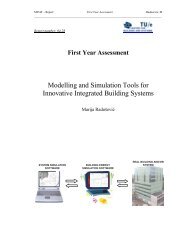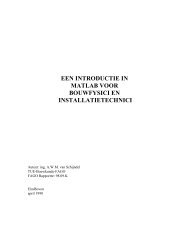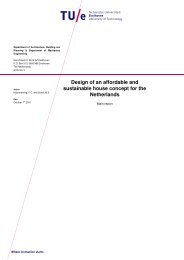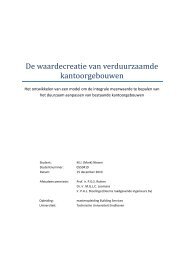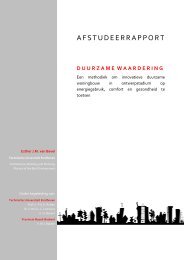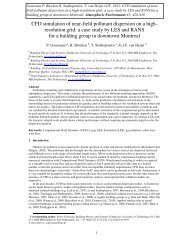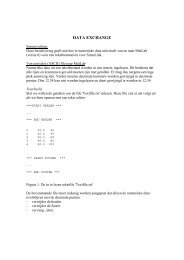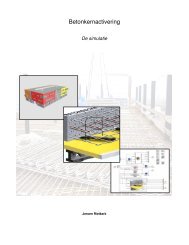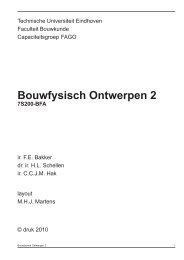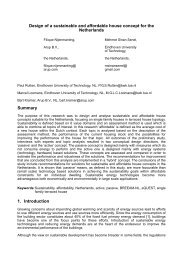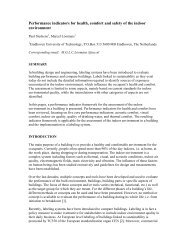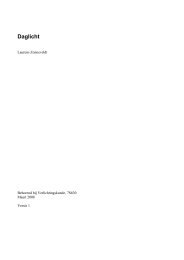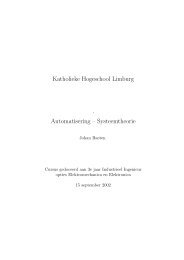Title of Contribution to ROOMVENT 2004
Title of Contribution to ROOMVENT 2004
Title of Contribution to ROOMVENT 2004
You also want an ePaper? Increase the reach of your titles
YUMPU automatically turns print PDFs into web optimized ePapers that Google loves.
Figure 6. Air and surface temperatures with seat andkneeler pad heating system operating6 CFD SimulationsThe set-up <strong>of</strong> the benches with the local heatingsystem in the climate room is modelled in the CFDpackage Fluent, version 6.1 [5]. In the simulationmodel the standard k-ε model is applied with thestandard wall functions. In this model a structural gridis applied with grid cells that grow from the areaaround the benches <strong>to</strong>wards the boundaries <strong>of</strong> theroom. The room boundary conditions like wall,ceiling and floor surface temperatures as well as theinitial surface temperatures <strong>of</strong> the benches werederived from the measurements in the climate room.A first simulation <strong>of</strong> the seat heating system isperformed.6.1 EvaluationThe first simulation results were evaluated withhelp <strong>of</strong> the measurements discussed before. Thisevaluation showed that the surface temperatures <strong>of</strong> thebenches (see figure 6) were in good agreement withthe measurements (figure 4). These figures show thesame temperature distribution on the wooden benchesand the heating system.The next step in this research is <strong>to</strong> investigatewhat kind <strong>of</strong> viscous model should be used <strong>to</strong> achievean accurate CFD simulation <strong>of</strong> the local climatebetween and around the benches.The results <strong>of</strong> this evaluation will be used <strong>to</strong>determine the parameters that are important as inputfor the simulations. First, this will be used forperforming simulations under the steady conditions <strong>of</strong>the climate room. In ongoing research, these resultswill be used for modelling and performing CFDsimulations <strong>of</strong> the situation in a church under realclimate conditions.7 ConclusionsFrom the measurements that have been performedin this research, the influence <strong>of</strong> the different heatingelements on the local climate in and around thebenches has become clear. The heating elementsunder the seat and in the back have the largestinfluence on this local climate. The air temperaturesbetween the benches increased up <strong>to</strong> 4°C, while atsome positions a maximum increase in surfacetemperatures <strong>of</strong> 10°C was measured. The mostimportant region <strong>of</strong> impact for air velocities is foundat shoulder height. The influence <strong>of</strong> the heatingelement under the kneeler pad is limited <strong>to</strong> the regionadjacent <strong>to</strong> this element.The first simulation results <strong>of</strong> the seat heatingsystem are in good agreement with the results <strong>of</strong> thesmoke tests and the infrared thermographic pictures,which give a general impression <strong>of</strong> airflows andtemperature distribution. For a more detailedverification, the temperatures and air velocitiesmeasured on the different positions can be used.In ongoing research this verification will beperformed for the two other heating systems. Afterthat, the model can be upgraded <strong>to</strong> the real situation inthe church building with the actual outdoor climateconditions.AcknowledgementsThe work presented in this paper is part <strong>of</strong> theEuropean project “Friendly Heating” which is fundedby the European Commission in the 5 th FrameworkProgram under contact no: EVK4-CT-2001-00067.The authors would like <strong>to</strong> acknowledge the financialsupport they have received from the EuropeanCommission.References[1] Schellen, H. L., 2002: Heating monumentalchurches: indoor climate and preservation <strong>of</strong>cultural heritage. Dissertation EindhovenUniversity <strong>of</strong> Technology, The Netherlands.ISBN: 90-386-1556-6[2] Arendt, Claus, 1993: Raumklima in grossenhis<strong>to</strong>rischen Raümen: Heizungsart,Heizungsweise, Schadensentwicklung,Schadensverhinderung. ISBN: 3-481-00564-4[3] www.isac.cnr.it/friendly-heating[4] Loomans, M.G.L.C, 1998: The measurement andsimulation <strong>of</strong> indoor airflow. DissertationEindhoven University <strong>of</strong> Technology, TheNetherlands. ISBN: 90-6814-085-X[5] Loomans, M.G.L.C.; Schijndel, A.W.M. van,1998: Simulation and measurement <strong>of</strong> thestationary and transient characteristics <strong>of</strong> the hotsphere anemometer. Eindhoven University <strong>of</strong>Technology, The Netherlands, FAGO report98.08.K[6] Fluent Inc., Fluent User’s Guide, version 6.1,Lebanon, USA, February 2003



